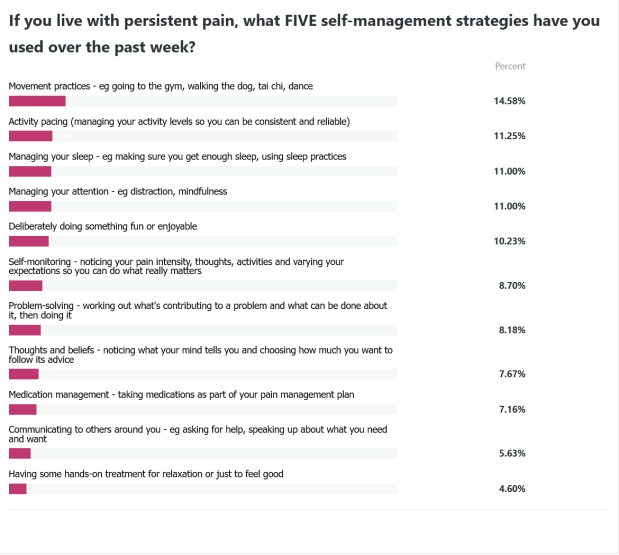There are few constructs more widely known in pain psychology than catastrophising. Defined as “an exaggerated negative mental set brought to bear during actual or anticipated pain experience” (Sullivan et al., 2001), catastrophising is associated with poor outcomes including greater pain intensity, distress and disability in almost every situation where pain is experienced (Sullivan & Tripp, 2024). Cognitive biases associated with catastrophising include interpretive bias, attentional bias and attentional fixation – in other words negatively interpreting situations, attending to the negative in a situation, and being unable to stop attending to what is troubling.
The term originally came from mental illness and the work of Ellis and Beck, where catastrophising was used to describe a focus on the worst possible outcome in a situation, or tending to overestimate the probability of a negative event. In pain research it was adopted by Sullivan and colleagues and thought to be ‘an exaggerated threat appraisal.’ In other words, making a mountain out of a molehill.
There are some troubling aspects to this term, and in the way it has been used with people living with pain. While it is strongly associated with negative outcomes, it’s important to dig a little more deeply into what is being measured and how. It’s also important to know how people living with pain experience this term, and to understand the way it has been used and abused to describe people with pain. My post this week and next will cover some of this!
About four years ago, much of the world experienced a collective moment of what we could now consider to be catastrophising. Remember then? It was at the start of the Covid-19 pandemic when nobody knew how the disease was transmitted, thousands of people were dying, and the global response was shutdown. Remember the toilet paper shortage? We might laugh now, but at the time we were really afraid. Anticipating the worst and planning for it, is a common human response to the unknown, even if some of us do this more than others.
For people with pain, particularly weird pain like complex regional pain syndrome or a bout of particularly nasty low back pain that doesn’t respond to the usual strategies, it doesn’t seem too far-fetched to worry like fury and to not be placated by reassurance. Especially if that reassurance is along the lines of ‘trust me, there’s nothing to worry about.’ Even more especially if that person has seen what has happened to others with similar problems. And then does an internet search and finds social media posts on the evils of lifting with a rounded back! We have to ask if pain-related distress is a realistic concern based on past experiences, patronising clinical responses (or worse, fear-evoking ones), and a sense of personal inadequacy to deal with weird pain. After all, if clinicians don’t know what to do, how would I, as an individual, know what it all means?
Turning to measurement now, and the main pen and paper measures used for this construct. A paper by Crombez and colleagues (2020) investigated item content validity, important psychometric property of measures for catastrophising. Most of us would know about construct validity (does it measure what we think it measures?), predictive validity (does it predict something important in the real world?), divergent and convergent validity (does this measure align with other similar measures, and differ appropriately with other measures that it shouldn’t relate to?)… Item content validity looks at the individual items within a measure, and asks participants to identify which construct that item looks like it taps into. Crombez and colleagues undertook this with several measures of pain catastrophising, using discriminant content validity method. They identified six constructs associated with the term pain catastrophising (including pain catastrophising); they then sought definitions for these using Oxford Dictionary definitions to avoid any theoretical bias. All measures that had been used to assess pain catastrophising were identified and the items extracted. In addition to the pain catastrophising items, they selected items that could be appropriate for the other five constructs, and included these in the list. Participants were then asked two questions for each item: 1) Did the item assess [insert construct]? yes or no; and 2) how confident participants were about their judgement (on a 0 – 10 scale anchored by 0% confidence and 100% confidence). The definition of pain catastrophising used in this study was ‘‘to view or present pain or pain-related problems as considerably worse than they actually are.’’
Cutting to the chase (but please do read the paper! It’s very thorough), using Bayesian hierarchical models, they analysed the items and responses. What they found is pretty challenging to read. Of the six instruments all considered to measure catastrophising, the CSQ (Coping strategies questionnaire, Rosenstiel & Keefe, 1983) and the AEQ (Avoidance Endurance Questionnaire, Hasenbring, Hallner & Rusu, 2009) was thought the most credible for measuring pain catastrophising, while the PCL (Pain cognition list, Vlaeyen et al., 1990) was not thought to measure the construct. Interestingly, the PCS (Pain catastrophising scale, Sullivan, Bishop & Pivik, 1995) was at the lower end of the rating, so participants didn’t think it measured what they thought of as catastrophising.
The next part of the study was intriguing: using the statistical analysis, the authors developed models comparing the score for ‘pain catastrophising’ to those for the five other constructs. This tells us how well each item was judged to fit the constructs under investigation. If the items from a measure fit the common understanding of ‘pain catastrophising’ we’d expect more people to agree with this, and with confidence. Hopefully the most commonly-used measure would be most closely associated with the construct as understood by these participants. But… you guessed it, none of the six instruments distinctively assessed pain catastrophising – most had content that participants judged to better fit the constructs ‘worrying about pain’ or ‘pain-related distress.’ Oooops.
What does this mean? Well firstly it’s going to rock a few boats because the PCS and pain catastrophising has been so extensively associated with poor outcomes. In fact, the authors stated in a recent paper (Crombez, Scott & De Paepe, 2024) “The message was clear, but not well received. The manuscript was rejected by many journals in the field. Admittedly, no study is perfect, but many comments of the reviewers were in line with the idea that “pain catastrophizing” has become “entrenched,” and resistant to change.” Note to researchers everywhere: if what you find doesn’t fit with the received view, it’s not going to get into print.
Then we need to do some serious thinking: if the measures used to assess pain catastrophising don’t measure what we think they do, what do we do with the accumulated findings based on their use? No, don’t toss that research on the scrapheap, the findings are what they are, and validly and reliably show that when people endorse the items in the PCS, the outcomes they report are not as positive as those who report lower levels of endorsement. What we need to question is what it is we are measuring. If not ‘catastrophising’ – then what? And why does it matter?
I do like the suggestion by Crombez and colleagues (Crombez et al., 2020; Crombez et al., 2024) that the term be removed and replaced by ‘pain related worry.’ Sullivan & Tripp think this trivialises the impact of catastrophising. Worry is somewhat ‘less’ – and they argue that if pain-related worry was the construct being measured, then surely studies examining worry and pain catastrophising would be similar (Sullivan & Tripp, 2024). However, pain-related worry is a little different from general worry, and I wonder if the items used to investigate pain-related worry represent what people who are worrying about pain actually think and do. The second point Sullivan and Tripp make is that by changing the term, the research that’s accumulated becomes somewhat suspect. I don’t agree: it stands as it is. We refine and reformulate concepts and models as we accumulate new information, and at least part of this process involves redefining what we call things.
The most compelling argument for changing the constructs name is that we simply do not have a gold standard way to measure ‘how bad’ the threat of pain is in people. There is no ‘predictor’ for the impact of pain on a person. Pain is subjective and my life experience and future hopes and dreams are similarly subjective. How can someone judge whether my worry about the impact of something on my life is ‘exaggerated’? Given the very real effects of pain on individuals’ lives including work life, relationships, sleep, mood, doing important things, AND paired with the often unhelpful information given to people by health professionals for many people the worry is absolutely on point. Unhelpful, but that’s a totally different topic.
Next week: the perspectives of people with pain….
Crombez, G., De Paepe, A. L., Veirman, E., Eccleston, C., Verleysen, G., & Van Ryckeghem, D. M. L. (2020). Let’s talk about pain catastrophizing measures: an item content analysis. PeerJ, 8, e8643. https://doi.org/10.7717/peerj.8643
Crombez, G., Scott, W., & De Paepe, A. L. (2024). Knowing What We Are Talking About: The Case of Pain Catastrophizing. Journal of Pain, 25(3), 591-594. https://doi.org/10.1016/j.jpain.2023.12.014
Rosenstiel AK, Keefe FJ. 1983. The use of coping strategies in chronic low back pain patients: relationship to patient characteristics and current adjustment. Pain 17(1):33–44 DOI 10.1016/0304-3959(83)90125-2.
Sullivan, M. J., Thorn, B., Haythornthwaite, J. A., Keefe, F., Martin, M., Bradley, L. A., & Lefebvre, J. C. (2001). Theoretical perspectives on the relation between catastrophizing and pain. Clinical Journal of Pain, 17(1), 52-64.
Sullivan, M. J. L., & Tripp, D. A. (2024). Pain Catastrophizing: Controversies, Misconceptions and Future Directions. Journal of Pain, 25(3), 575-587. https://doi.org/10.1016/j.jpain.2023.07.004
Vlaeyen JWS, Geurts SM, Kole-Snijders AMJ, Schuerman JA, Groenman NH, Van Eek H. (1990). What do chronic pain patients think of their pain? Towards a pain cognition questionnaire. British Journal of Clinical Psychology 29(4):383–394 DOI 10.1111/j.2044-8260.1990.tb00901.x.
















